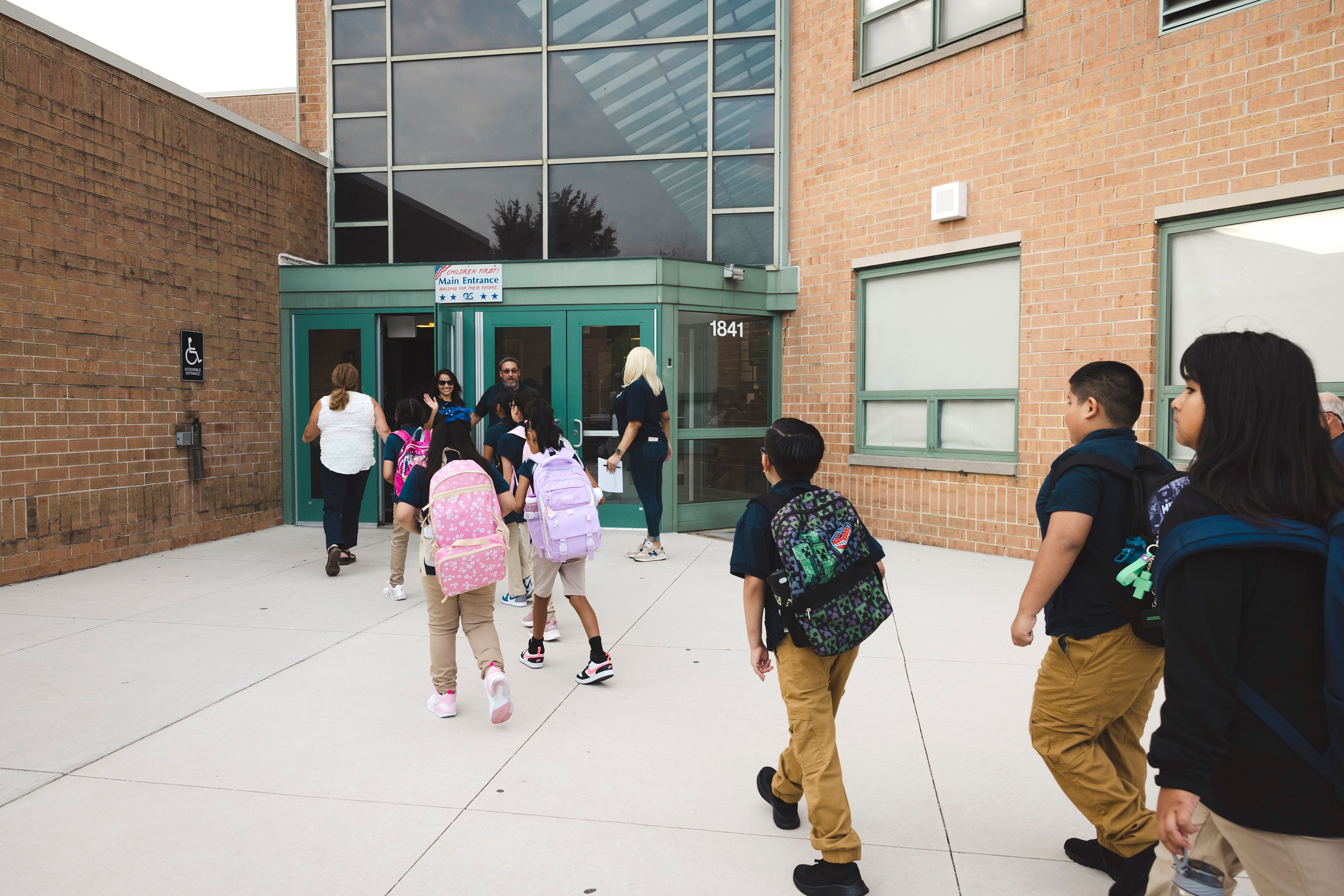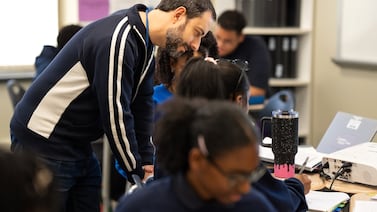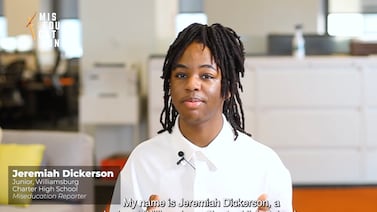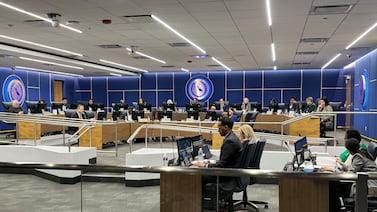Sign up for Chalkbeat Chicago’s free daily newsletter to keep up with the latest education news.
The Chicago Board of Education is responsible for the education of about 323,000 students enrolled in Chicago Public Schools, currently the nation’s fourth largest school district.
The vast majority are students of color, with 47% identifying as Hispanic, 35% as Black, 11% as white, and 4.5% as Asian American. About 70% come from low-income households, 16% are students with disabilities, and 24% are learning English.
These demographics shifted over the past decade — as Black families left Chicago, birth rates declined, and new immigrants arrived.
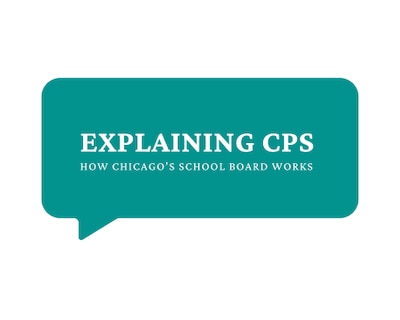
The 2023-24 school year was the first time since 2011 that CPS saw an increase in student enrollment with 323,251 children enrolled as of the 20th day of school, when the district takes its official count. That was 1,185 more students than the year prior.
What’s more, Chicago’s public school enrollment as of mid-April 2024 rose by more than 5,000 students to 328,971, according to district officials and a Chalkbeat analysis of preliminary enrollment data from the spring.
The proportion of Black students has declined, while the number of Latino, white, and Asian American students has grown. Chicago has also seen a large decline in students who come from low-income households. Although still a large majority of the CPS student body, low-income students now make up 71% of enrolled CPS students as opposed to 86% in 2011 – a decline of 15 percentage points.
As the Chicago Board of Education shifts from being appointed by the mayor to elected by voters, the demographics of each school board district can be a window into what elected representatives advocate for and what matters to CPS families.
Although each school board district represents 275,000 Chicagoans, the number of schools and students attending those schools varies significantly. For example, District 5 has 105 schools within its boundaries, while District 4 has just 34. And the racial demographics of students enrolled in the schools within each can vary widely.
CPS enrollment changes over time
The number of students in CPS has been declining steadily for years. Thirteen years ago, 400,000 students were enrolled in CPS, but in recent years that number has hovered around 320,000, according to district enrollment data. In 2022, Chicago became the nation’s fourth largest school district after decades as the third largest.
Demographic shifts have sometimes coincided with major events.
In the wake of Chicago closing 50 schools in 2013, enrollment dropped. But the sharpest declines occurred between 2016 and 2018, when the district lost approximately 10,000 students each year. Between 2019 and 2020, when the pandemic shut down in-person schooling, enrollment decreased by nearly 15,000 students.
In 2020, with the emergence of COVID and virtual learning, total enrollment in the U.S. dropped by 3% in the first year of the pandemic, according to the National Center for Education Statistics. In 2021, nationally, enrollment numbers stabilized, but in Chicago, the decline continued, with another 10,000 students leaving CPS.
Declining enrollment seems to have stopped in the past school year, as waves of new migrant families have arrived from the southern border.
How student racial demographics have shifted
Chicago Public Schools serve mostly Black and Latino students, but the share of each racial group has shifted over time.
In 2010, Black students made up 43% of CPS and Latino students were 44%. Today, Black students are 35% of CPS students and Latino students are 47%.
Chicago’s overall Latino population has also edged out Black Chicagoans as the second largest ethnic group in the city, making up 29% of the city’s population in 2023, according the U.S. Census bureau’s estimates.
The number of Latino students in CPS steadily increased from 2010 to 2013, but despite the city’s growing population of Latino residents, Latino enrollment numbers began to decline in 2014, just after 50 CPS schools were closed primarily in majority-Black areas on the South and West sides in 2013.
Latino student enrollment dipped by its largest margin — about 2,700 students — in 2016 as well. But since then, the number of Latino students enrolled in CPS had steadily declined by about 3,000-5,000 students each year.
That is, until the 2022-23 school year, which saw an increase of 1,959 Latino students.
There have been less dramatic increases in the number of White and Asian American students, except during the pandemic years when enrollment across nearly all ethnic groups declined. The number of Asian American students, who make up 4.5% of CPS students today, increased by 1,704 students overall since 2010, with little variation over the past decade and a half. Asian Americans are about 7% of Chicago’s population.
The number of white students in CPS also increased by 1,291 students since 2010, steadily increasing until 2020 and now inching back towards pre-pandemic levels. Although white Chicagoans are the largest ethnic majority in the city, white students only make up 11% of CPS students.
Fewer CPS students from low-income households, more English learners
Chicago Public Schools is serving fewer low-income families than it did a decade ago — in part due to gentrification in some neighborhoods and less public and affordable housing.
The number of CPS students who have Individualized Education Programs, or IEPs – programs and services for students who require extra support – has also seen an overall increase of about 2,500 students. However, the number of students with IEPs has bounced back and forth between 49,000 and 52,000 for the last decade and a half and that trend continues with the 2023 enrollment numbers at 51,910.
The group with the largest increase in enrollment since 2011 is English language learners. Even as enrollment has declined overall, the number of English language learners has increased by nearly 16,000 students since 2011.
Students who speak multiple languages now make up 25% of CPS students. With plans to expand dual-language programs, the district is working to keep up with the influx, but designated bilingual educators working with students who are recent migrants say they’re overwhelmed and need resources beyond staffing.
Except for dips in enrollment in 2016 and 2020, that number has steadily increased every year since 2011. The largest increase occurred just last year, when nearly 8,000 additional students were identified as English language learners.
These factors can play a role in a school’s performance and most of these designations also drive funding and policy decisions. Chicago’s Board of Education announced this spring that it is moving away from a system of budgeting where dollars mostly follow students, in favor of a new needs-based model that considers factors such as the number of students who are homeless, low-income, English language learners, or have IEPs. The new model also takes into account a school’s diversity and the socioeconomics of its surrounding community.
Birth rates decline as pre-K expands
Chicago has been seeing fewer babies born every year since the early 1990s. The city’s decline matches a national downward trend in birth rates that began in 2007 around the time of the Great Recession.
Declining birth rates showed up roughly five years later in schools, as the number of incoming kindergarteners decreased annually, replacing a larger group of graduating seniors.
But while school enrollment has steadily declined overall, the district has spent millions on expanding its free public pre-K programs since 2020 and it seems to be paying off.
Pre-K enrollment reached a peak in 2019 at 14,300 students, before declining to 9,540 during the pandemic. Now, with 13,097 pre-K students enrolled during the 2023-24 school year, pre-K enrollment numbers are nearly at the same level they were in 2016.
Preschool enrollment has also seen an increase of about 2,578 students since the pandemic, but there’s still a way to go before reaching pre-pandemic preschool enrollment levels of just over 7,000 students.
Crystal Paul is a freelance reporter and editor.
Becky Vevea is the bureau chief for Chalkbeat Chicago. Contact Becky at bvevea@chalkbeat.org .

